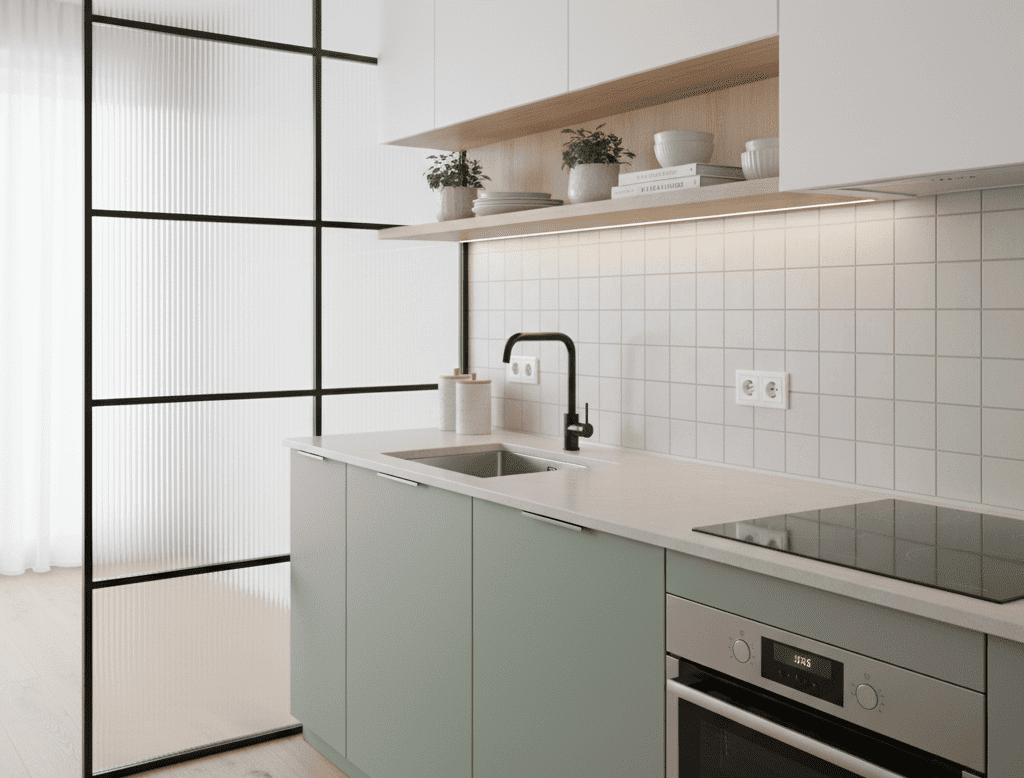Top-5 Solutions for a Small Kitchen
A small kitchen is not just about square meters—it’s about how those meters are arranged, how light falls, how the air moves. People often say: “It’s just cooking, I don’t need much space.” But reality bites. If you’ve ever tried to chop vegetables while the fridge door blocks the stove, you know the chaos.
It’s not only physical. A tight kitchen presses into your mood. You begin to hate cooking, avoid inviting friends, feel boxed in. The good news? Design can be more powerful than demolition. You don’t need to move walls to create breathing room.
What This Guide Will Do
This isn’t about random Pinterest tricks or some sterile “ten ways” list. It’s about five strong, grounded solutions that rewire how a small kitchen behaves. Each of these pulls from professional design—real strategies tested in studios, apartments, even micro-homes.
- Materials that stretch light.
- Wood that warms.
- Dividers that don’t divide.
- Glass that doesn’t suffocate.
- Digital planning that saves mistakes.
By the end, you’ll see that a kitchen can be small yet still feel like a stage, a workshop, a retreat—whatever you want.
1. Break the Ceiling with Materials
I’ve seen cramped apartments feel taller, wider, even louder just because of one bold choice. Take the idea of metallic finishes—they bounce light, trick the eye, push depth where there isn’t any. High-tech designers figured this out in the 80s, and the revival today makes sense.
- Pros
- Reflects light, creates illusion of space
- Easy to clean surfaces
- Modern aesthetic that feels sharp
- Cons
- Can feel cold if overdone
- Shows smudges and fingerprints
Add one brutal shiny surface and suddenly the whole room has a backbone.
2. Work with Wood (Yes, Really)
Everyone preaches minimalism. But minimal doesn’t always mean sterile. Using mass-timber elements—even in the tiniest kitchen—brings warmth. It’s tactile, calming, alive.
Tables, beams, even a small shelving unit of engineered wood can change the vibe. It’s not just about looks either; wood absorbs noise, balances the stark echoes that small spaces trap.
- Advantages:
- Natural texture softens hard angles
- Environmentally friendly choice
- Matches both modern and rustic kitchens
- Disadvantages:
- Needs maintenance (oil, sealing)
- Can feel heavy if used in bulk
3. Divide without Killing Flow
This is where zoning plays hero. People think partitions shrink space, but clever dividers do the opposite. Look at space zoning ideas: a rug, a bookshelf, even curtain partitions. In a studio kitchen, carving boundaries means freedom.
Some tricks:
- Place a tall plant or open shelving to mark cooking vs. dining.
- Use light track fixtures to separate prep from lounge zones.
- Rugs under a small table = instant zone shift.
It’s psychology. Once you feel an edge, your mind stops screaming “tiny box.”
4. Glass Is Your Ally
Here comes the dangerous one—because done wrong, it looks like an office lobby. But custom glass partitions are lifesavers for small homes. They let in light, provide privacy, and never crush a room.
Some architects even whisper radical advice: Some architects recommend glass wall systems to visually expand space.
That line alone could save you. Imagine cooking inside a corner glass cube, with light pouring in. It’s functional, stylish, and yes, a little dramatic.
5. Go Digital (Even with Kitchens)
Not about smart fridges, no. More about presentation. If you want to plan, rethink, or just experiment—check interior design templates. These aren’t just for web designers; they’re visual guides. You sketch, drag, play with colors, layouts, textures.
When I used a template mockup for my own kitchen plan, I realized the oven was in the worst possible spot. Changed it before drilling holes. Saved hundreds.
Bonus Thought: Bathroom Lessons in the Kitchen
Weird crossover, but trust me. Designers who create serene bathrooms know how to inject “retreat energy” into any space. Think about bathroom retreat ideas: ambient lighting, organic textures, minimal vanity tricks. Why not steal those moves for your tiny kitchen? Soft under-cabinet light, warm palette, cozy textures. Suddenly the kitchen is less battlefield, more sanctuary.
Another Angle: The Social Kitchen
We talk about design as if it’s only surfaces and materials, but a kitchen is a social engine. Even a small one. Some designers argue: it’s not size that matters, it’s choreography. Can two people cook without elbow wars? Can a guest sit while you stir soup?
Ideas to try:
- Add a folding stool under the counter—suddenly you’ve got “seating” without swallowing space.
- Make one wall magnetic for knives, spoons, reminders—freeing counters for action.
- Hang pots vertically, not stack them. Gravity gives you storage.
- Think circulation: a triangle between stove, sink, and fridge—even in a 5m² kitchen—feels better than a random scatter.
These are not aesthetic moves. They are survival moves. But survival in style.
Quick Comparison Table
| Solution | Space Impact | Cost | Atmosphere | Risk |
|---|---|---|---|---|
| Metallic Finishes | High | $$ | Sharp, modern | Cold feel |
| Mass-Timber | Medium | $$$ | Warm, calming | Maintenance |
| Zoning Tricks | Medium | $ | Flexible, dynamic | Clutter risk |
| Glass Partitions | High | $$$ | Airy, open | Office vibe |
| Digital Templates | Planning only | Free–$ | Visual clarity | Tech learning curve |

Wrapping It All Up
Here’s the truth: small kitchens don’t get bigger. But they can feel bigger, function smarter, and even become places you want to linger. Whether it’s the shimmer of metallic finishes, the calm grain of timber, or a piece of glass catching morning light—these moves aren’t gimmicks, they’re weapons.
The trick isn’t to fight the size. It’s to flip it. Small space means every element matters. No waste. No fluff. And that’s liberating. Your kitchen stops being a compromise and starts being a design exercise—a puzzle you solved.
So, when people complain about tiny cooking spaces, maybe smile. Because with a little zoning, some wood, a flash of glass, you’ll have a room that works harder than most palatial kitchens. And maybe, just maybe, you’ll even like cooking again.
FAQs
Q1: What’s the fastest way to make a small kitchen feel bigger?
Add reflective surfaces—metallic finishes or glass—to expand light and create depth.
Q2: Are wood elements suitable for humid kitchens?
Yes, if treated. Sealed mass-timber or engineered wood resists moisture far better than raw cuts.
Q3: Do partitions actually help in tiny homes?
Yes. Even soft divisions like rugs or curtains trick the mind into believing there’s more room.
Q4: Can bathroom design tips really apply to kitchens?
Absolutely. Mood lighting and organic textures improve atmosphere in any small space, not just bathrooms.
Q5: How do you make a kitchen social without more square meters?
Focus on flow—triangle layout, small stools, wall-mounted tools. Movement, not size, creates comfort.
